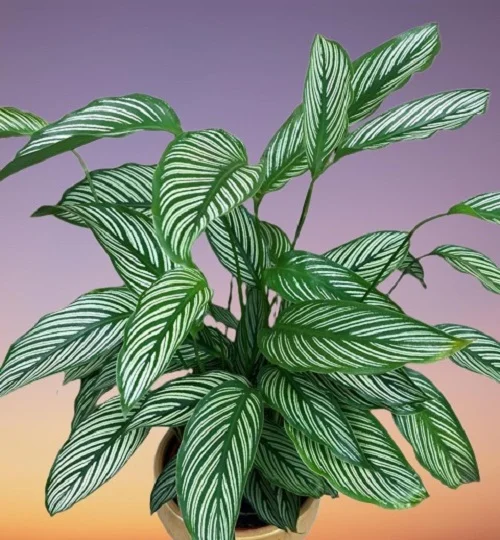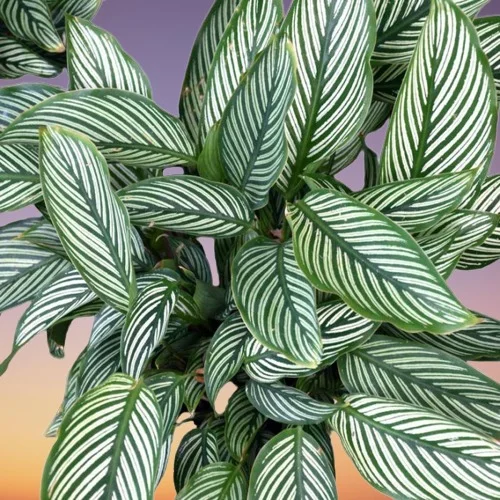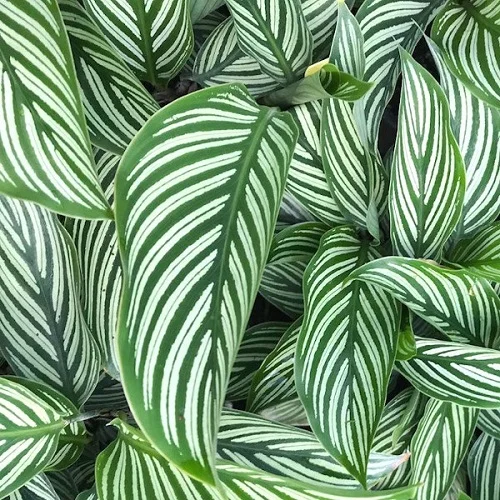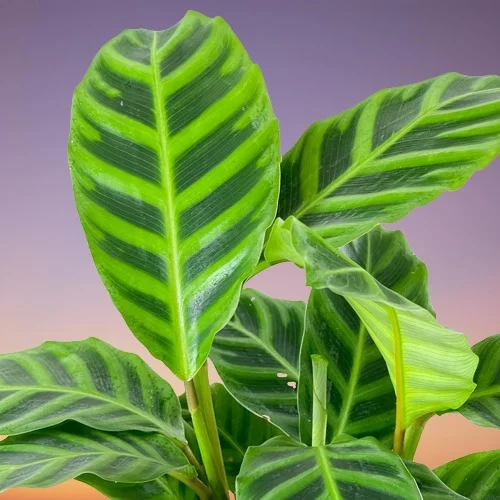Calathea vittata (Goeppertia elliptica) Indoor Care, Common Problems and Fixes
Some links in this post may be affiliate links
Calathea vittata (Goeppertia elliptica) flourishes in medium to bright indirect light, warm and humid conditions and consistently moist, rich, well-drained soil coupled with monthly feeding in the growing season.
Calathea have a bit of a diva reputation when it comes to care. But with the right care, Calathea Vittata will thrive indoors. In this guide, we will cover everything you need to know about Goeppertia elliptica indoor care.
First, let's dig into some facts about this plant. Calathea Vittata also called Calathea elliptica is one of the popular Calathea varieties and bears elliptical, bright-green leaves with distinctive white stripes and burgundy-purple undersides.
Goeppertia elliptica is among the best plants for the office space and has become a favorite recently that will truly stand out in any plant collection.

Botanical name: Calathea vittata
Synonym: Goeppertia elliptica, Calathea elliptica
Family: Marantaceae
Common name: Elliptica
Origin
Calathea elliptica is native to the tropical forests in Brazil and South America where it grows as an understory plant. It is among the best tropical foliage plants that you can grow in the home, office or any other suitable place.
Size
Goeppertia elliptica grows to a height of about 1-1.5 feet and about 1 foot wide which makes it one of the best low-light plants for the limited spaces.
Flower
Calathea vittata is not grown for the flower but for its pretty foliage and it is unlikely to flower under room conditions.
Is Calathea vittata pet-friendly?
Yes. Calathea vittata like other Calathea Plants is non-toxic to both humans and pets as indicated by ASPCA. It is safe for cats, dogs and other pets in the home and any other space.
Related Plants
Calathea vittata is related to the Marantas, Ctenanthe and Stromanthe which are collectively called Prayer Plants in reference to their curious characteristic of closing their leaves at night.
Where to Buy
Calathea elliptica are outstanding plants for your collection. You may get these plants online from Amazon (Link to Amazon).

How do you care for Calathea vittata indoors?
To care for Calathea vittata indoors, provide medium to bright indirect light (dappled light), average warmth of 18-280C, humidity of 60-80% and consistently moist, fertile, well-drained soil coupled with monthly feeding in spring and summer.
Goeppertia elliptica care requires repotting when it has become pot-bound. Pruning is necessary to keep it neat and also minimize pest and disease infestations. Keep reading for more on these growing conditions and how to achieve them.
Watering
How do you water Calathea vittata?
Water your Calathea vittata liberally during the growing season (spring and summer) and allow the top 1-2 inches of soil to dry out between waterings. Keep the soil consistently moist but not soggy to avoid rotting, drooping and yellowing leaves.
Lessen watering in the cold season (fall and winter) as growth is minimal at this time to keep the soil slightly moist. Do not allow the soil to dry out completely to prevent yellowing and drooping leaves.
Use water that is at room temperature to avoid plant shock which can result in reduced growth and death of the plant. Use water that is free of chlorine and flourides which can lead to brown leaf tips and edges.
Make sure that the pot has a drainage hole and the soil is free-draining to prevent waterlogging as it can lead to yellowing, wilting, root-rot and death of the plant.
To reduce fungal infestations like leaf spot disease, avoid wetting the foliage during watering or water from the bottom instead.
Light Requirements
Where should I put Calathea vittata in my house?
Calathea vittata grows best in medium to bright indirect light (filtered light). Put it near a brightly-lit window away from direct sunlight to prevent scorching of the leaves. Avoid too bright light as it will cause the leaf colour to fade and appear washed out.
If your plant is getting curled leaves, leggy growth, or losing its stripes, the light is not enough. Move the plant infront of a large, well-lit window or consider investing in grow lights if you do not have adequate light in your home.
For even growth and to prevent unbalanced growth, regularly turn the pot to ensure that the plant receives light on all sides.
Temperature & Humidity
Calathea vittata prefers an average warmth of 18-280C. Below this range, the plant stops growing while above this range the plant may die.
Keep the plant away from drafts sources like windy doors, drafty windows, air conditioning units, hot stoves and others as they cause sudden changes in temperature which can result in curled leaves, drooping, stunted growth and death of the plant.
Goeppertia elliptica requires a humidity of 60-80% to thrive. Low humidity can lead to brown leaf tips and edges. Use a hygrometer to monitor the humidity for the optimum growth of the plant. To up scale humidity, set the pot on a wet pebble tray or grow the plant in a well-lit bathroom and other moist areas in the home. Ascertain that there is good air circulation to minimize fungal diseases.
You may also grow the plant in a closed terrarium. On account of its compact size and requirement for humid conditions, Calathea vittata is one of the best plants for a closed terrarium.
Fertilizer
What is the best fertilizer for Calathea vittata?
Feed your Calathea vittata with a balanced, liquid fertilizer every 4 weeks through out the growing season (spring and summer) for a lush growth.
Withhold feeding in the cold season (fall and winter) as growth is minimal and feeding at this time can lead to fertilizer burn resulting in brown leaf tips and edges.
Flush out accumulated chemicals (salts) from the soil every 1-2 months by running a stream of water through the soil. Allow the stream of water to run for some time and repeat the process several times.
Soil
What kind of soil does Calathea vittata like?
Calathea vittata likes a rich, light, airy, and well-draining soil that retains moisture but does not get soggy. A blend of 1 part peat moss or coconut coir (for moisture retention), 1 part perlite (to improve drainage) and 1 part potting soil (to provide nutrients) is perfect for this plant.
Repotting
Repot Calathea vittata every 2-3 years at the beginning of the growing season (spring to early summer), when it becomes root-bound. Take care not to injure its delicate roots.
Select a pot one size larger than the current one. Ensure that the pot has a drainage hole to prevent the soil from getting soggy to avoid rotting and death of the plant. Check out these self waatering planters with drainage hole on Amazon.
Before repotting, water the plant thoroughly at least 1 day before to hasten establishment. A well hydrated plant suffers less repotting shock and takes a shorter time to take root.
If the plant is large and has outgrown its current pot, divide it into several sections and use the splits to propagate new plants.
Repotting may cause the leaves to droop but the plant will eventually recover once it takes root; in about 3-4 weeks.
Pruning & Grooming
Pruning Calathea vittata involves removal of dead and yellow foliage to maintain the plant neat and tidy. It also discourages pest and disease infestations. Cut the leaves at the base with a sharp knife or pair of scissors, where the leaf meets the stalk.
Occasionally clean the leaves by damp-wiping with a soft cloth to get rid of dust as well as minimize pest and disease infestations.
Calathea vittata Propagation
Calathea vittata (Goeppertia elliptica) is easily propagated by plant division during repotting. The best time to propagate is at the beginning of the growing season in spring as the plant is in the active growing phase which hastens establishment.
Learn how to propagate Calathea vittata (2 Ways of Goeppertia elliptica Propagation).

Calathea vittata Problems & Remedies
Calathea vittata (Goeppertia elliptica) problems are brown leaf tips, curling leaves, yellow leaves, drooping leaves, plant dying, washed out leaves, pests and diseases among others. Keep reading for more on these problems and how to fix them.
Brown leaf tips and edges
Brown leaf tips and edges on Calathea vittata are caused by low humidity, spidermites infestation, hard water or salts buildup.
How to fix it
- Low humidity: To raise humidity, set the pot on a wet pebble tray or use a humidifier. You can also grow the plant in a well-lit bathroom and other moist areas in the home.
- Spider mites infestation: Regularly check betwwen and underneath the leaves for pests and carry out timely corrective measures.
- Use of hard water: Use rain water, filtered water or distilled water.
- Salts buidup: Once in a while, flush out these salts from the soil by running a stream of water through the soil until it comes out through the drainage hole.
Curling leaves
Curling leaves on Calathea vittata are caused by overwatering, soggy soil, underwatering, direct sunlight, too little light, temperature stress or overfeeding.
How to fix it
- Overwatering: Do not water on a schedule; water when the top 1-2 inches of soil feel dry.
- Soggy soil: Pot the plant in free-draining soil and a pot with a drainage hole.
- Underwatering: Do not allow the soil to dry out completely.
- Exposure to direct sunlight: Place the plant in a shaded place or use a light curtain to filter the sunlight.
- Too little light: Position the plant infront a large bright window where it will receive bright indirect light or use a grow light if the natural light is not enough.
- Temperature stress: Keep the plant from drafts emanating from hot stoves, AC units, drafty windows, windy doors among others.
- Overfeeding: Take care not to overfertilize. Feed monthly in spring and summer. Do not feed in fall and winter.
Yellow leaves
Some of the causes of yellow leaves on Calathea vittata are inconsistent watering, soggy soil, extreme temperatures, lack of nutrients or too little light.
How to fix it
- Inconsistent watering: Water when the top 1-2 inches of soil dry out but never allow the soil ball to dry out completely.
- Soggy soil: Use a pot with a drainage hole and well-draining soil. In addition, empty the saucer after watering.
- Extreme temperatures: Keep the plant away from sources of drafts like AC units, heat sources, windy doors, drafty windows, hot air vents among others.
- Lack of nutrients: Fertilize the plant with a balanced, liquid fertilizer every 4 weeks in spring and summer.
- Too little light: Place the plant where it will receive medium to bright indirect light or use a grow light if the natural lighting is too low.
Drooping leaves
Drooping leaves on Calathea vittata are caused by dry air, improper watering or being root-bound.
How to fix it
- Too dry air: To up humidity, set the pot on a wet pebble tray, use a humidifier or grow the plant in a terrarium.
- Incorrect watering: Maintain the soil moist but not soggy and do not allow the soil to dry out completely.
- Being root-bound: Repot the plant into a pot one size larger than the current one or divide it into several sections to propagate new plants.
Check out these 10 Causes of Calathea Drooping Leaves and How to Revive It
Plant dying
Calathea vittata is dying due to due to inconsistent watering, temperature stress, nutrients deficiency, low humidity, pests infestations and root-rot.
How to fix it
- Inconsistent watering Water when the top 1-2 inches of soil dry out but do not allow the soil to dry out completely. Do not water on a schedule.
- Temperature stress: Keep the plant away from drafts emanating from AC units, heat sources, windy doors, drafty windows, hot stoves among others.
- Nutrients defeciency: Fertilize with a balanced, liquid fertilizer every 4 weeks in spring and summer.
- Low humidity: To increase humidity, set the pot on a wet pebble tray or use a humidifier.
- Pests infestations: Regularly inspect the plant for pests and carry out timely control measures.
- Root-rot: The disease is prevalent in soggy soil.
- Carefully slip the plant out of its pot and inspect the roots.
- Trim the brown-black, mushy roots and treat the healthy roots with a copper-based fungicidal solution as indicated on the label.
- Disinfect the pot with the fungicidal solution or use a fresh pot to repot the plant in fresh, well-draining soil.
- Do not water the plant immediately and keep it dry for 5-7 days before you can resume watering.
- Use a pot with a drainage hole and well-draining soil to prevent the soil from getting soggy.
- Lessen watering in fall and winter as growth is slowed at this time; keep the soil slightly moist.
- Isolate the affected plant to prevent spread to the rest of the plants.
- Treat the infested plant with neem oil or insecticidal soap as per the manufacturers' recommendations.
- Regularly check underneath and between the leaves for these pests and carry out timely control measures.
- Keep the plant well pruned and raise humidity to discourage pest infestation.
- Remove and burn the affected parts to reduce the risk of spread to the rest of the plants.
- Spray the affected plant with a systemic fungicide and ensure to follow the manufacturers instructions.
- Maintain the plant on the dry side for some time and ensure good air flow.
- Use a pot with a drainage hole and well-draining soil.
Take a look at these 12 Reasons Why Calathea is Dying and How to Save It.
Washed out leaves
Washed out leaves on Calathea vittata are due to exposure of the plant to direct sunlight. Position the plant in a more shaded spot or instal a light curtain to shield it from direct sunlight.
Pests
Commoon pests on Calathea vittata are mealybugs, aphids, scale insects and spider mites.
How to fix it
Diseases
Calathea vittata is prone to leaf spot disease due to the humid conditions in which it grows. The disease is characterized by brown patches surrounded by a yellow halo (brown, soft leaf spots).
How to fix it
Conclusion
Calathea Vittata is a stunning, tropical beauty that elevates any indoor space. With proper light, humidity, and watering, it will reward you with lush, patterned foliage all year round. Although it has a reputation for being fussy, once you understand its needs, it becomes a low-maintenance, rewarding houseplant.
Frequently Asked Questions
1. How often should I water Calathea vittata?
Water Calathea vittata when the top 1-2 inches of soil dry out. Do not water on schedule.
2. Why are my Calathea Vittata’s leaves folding up at night?
This is a characteristic of prayer plants which include Calatheas; their leaves move up and down throughout the day.
3. Can I grow Calathea Vittata in a bathroom?
Yes. If your bathroom has bright indirect light, it’s a perfect spot because of the natural humidity.
4. How fast does Calathea Vittata grow?
Calathea Vittata is a moderate grower; you will see new leaves every few weeks in ideal conditions.
5. Why are the leaves of my Calathea vittata are turning yellow?
Cause of yellow leaves in Calathea vittata is overwatering. Water when the top 1-2 inches of the soil are dry.
6. Do I need to repot my Calathea Vittata?
Repot Calathea vittata every 2-3 years or if you notice the roots outgrowing the pot.
You liked it? Share on social media.
Related Content
Amazon Associates Disclosure
Homeplantsguide.com is a participant in the Amazon Services LLC Associates Program, an affiliate advertising program designed to provide a means for sites to earn advertising fees by advertising and linking to amazon.com.





